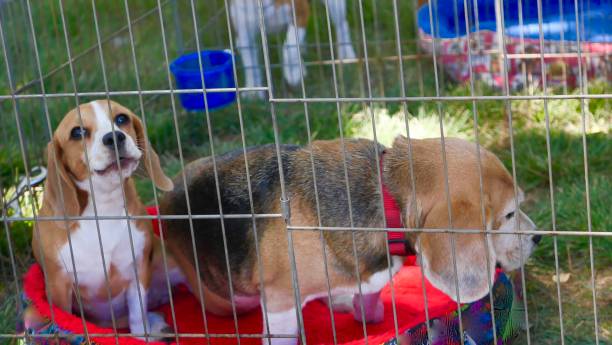Influence of Housing Conditions on Beagle Behaviour

The effects of different spatial areas and different social conditions on behaviours of beagles maintained in a laboratory were evaluated. Eighteen female purpose-bred beagles were divided into six groups of three, and housed individually for 3 months each in six different housing conditions: (A) a 6.1 m×9.1 m outdoor pen; (B) a 1.8 m×6.1 m outdoor run; (C) a 1.2 m×3.66 m indoor run: (D) a 0.9 m× 1.2 m×0.84 m cage; (E) a 0.9 m× 1.2 mX0.84 m cage with 30 min of forced treadmill exercise, 5 days week- ~; (F) a 0.71 m × 0.86 m × 0.69 m cage. Behaviours of six dogs housed in pairs in Conditions A and C were also compared. Behaviours studied were movement, vocalisation, lying down, sleep, object manipulation, barrier manipulation, barrier jumping, fence running, agonistic and affiliative activities, and proximity. Behavioural effects were compared among housing conditions, order of rotation through each housing condition, and behavioural changes over time during each 3 month rotation. Dogs spent more time moving in pens and runs than in cages. Dogs housed in the greatest degree of social isolation spent the most time moving, exhibited the greatest number of bizarre movements, and vocalised the most. Dogs housed in the smallest cages spent more time grooming and in manipulation of enclosure barriers than those housed in any other conditions. Forced treadmill exercise did not significantly alter behaviours. When housed in pairs, dogs spent more time sleeping and showed a tendency to spend less time vocalising than when housed singly. The results indicate that spatial area and activity are not likely to be the most important factors to be considered when evaluating psychosocial well-being of dogs. In assessing the psychosocial well- being of dogs, social isolation may be as harmful or more harmful than spatial restriction.
Hetts, S., Clark, J.D., Calpin, J.P., Arnold, C.E., and Mateo, J.M. (1992). Influence of housing conditions on beagle behaviour. Applied Animal Behavior Science, 34, 137-155.
Photo: iStock.com/Laura Fay
View ResourceTopic(s): Adequate Space, Behavior, Dog to Dog, Environment, Kennel Design, Research and Teaching, Social Interactions